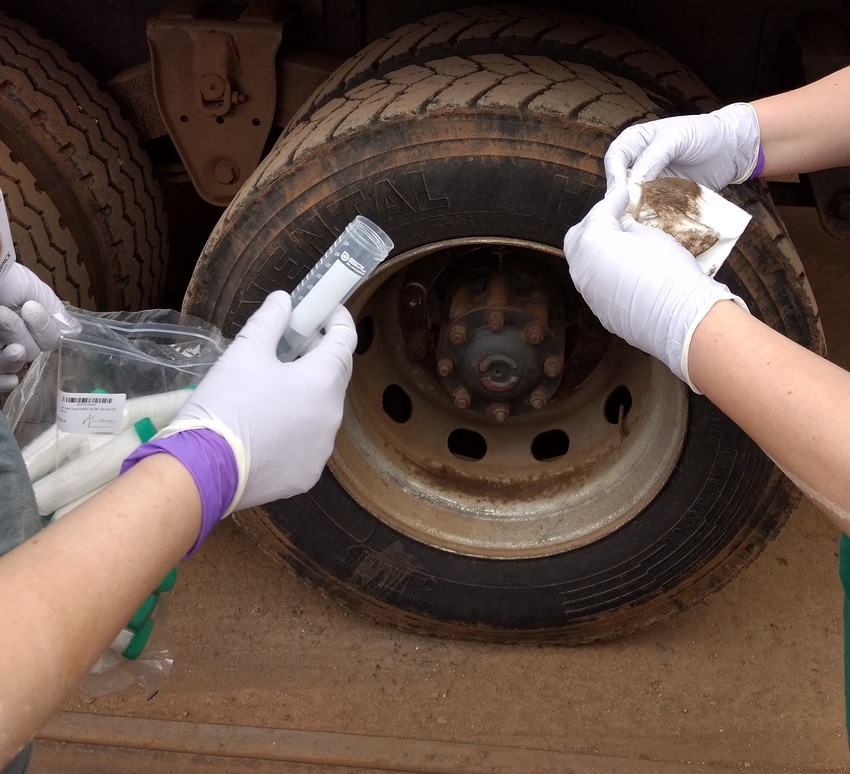PEDV break provides opportunity to investigate biosecurity gaps
The environmental swabbing exercise helped the team identify key problem areas on the farm, including the office and the shower.

When the Kansas State Swine Teaching and Research Center broke with porcine epidemic diarrhea virus last spring, the researchers, led by K-State swine specialist Steve Dritz, began environmental swabbing the farrow-to-finish site — first two weeks after the infection, and then again at four, six, eight, 12 and 16 weeks. The team swabbed at different locations and characterized them based on risk, finding the highest risk areas were allowing the virus to travel some distance from the farm.
“The highest risk for transfer to other locations were those outside of the fenced perimeter,” says Cassie Jones, associate professor and member of the Kansas State University Feed Safety Team. “There was no reason, based on our biosecurity protocols, that we should have had any virus leaving the farm, but it was. We found PEDV-positive PCR swabs in employee apartments, student vehicles and in the walkways to and from the farm. Our highest concern was around how can we clean up those areas first.”
As the team further examined the positive areas outside the farm’s perimeter, Jones says several of them were linked to dirty and contaminated transition zones, transition zones that the K-State team thought were going to be capable of maintaining and controlling the virus.
“In fact, some of those transition zones were even dirtier than areas inside the perimeter and closer to barns,” Jones says. “Certainly, as we looked at non-pig contact areas and pig contact areas within the farm, we had high levels of contamination as you would expect in the midst of an outbreak, but fortunately no positives were ever detected at the feed mill or at a nearby nursery that served as our gilt isolation unit.”
The environmental swabbing exercise did help the team identify key problem areas on the farm, including the office and the shower. In fact, 81% of the transition area samples (shower/changing area and office) and 66% of samples from non-pig contact areas outside the barns initially tested positive for PEDV.
“The floors and the desks of the employees that work within the farm continued to be a potential risk, but it took us swabbing those areas repeatedly to understand that people movement can significantly contribute to transmission of virus from one location to another,” Jones says. “For example, at one point one of the employee’s desks had a higher level of PEDV RNA than some of the lactation stalls that had been previously housing sows shedding virus.”
The team also found quite a bit of contamination throughout the shower area. This was attributed to dirty coveralls being left in the shower or laundered within the transition area. After following the suggestion of farm employees, the coveralls are now moved out of the transition area altogether and the additional step has kept the area free of viral contamination.
Finally, recognizing that transmission would be almost certain if the virus were to get into the feed supply chain, the K-State team moved a feed truck to the inside of the farm perimeter and kept the truck going back and forth to the feed mill segregated and outside of the perimeter. Jones says even though biosecurity protocols, such as changing shoes and boots were in place, the truck cab and tires of the feed truck inside the fenced perimeter tested positive for PEDV.
“That continues to be a risk. If we would have allowed that truck to go back into the feed mill, we would have been at very high risk for feed mill contamination from the farm into the mill and then subsequently a potential source to other farm units,” Jones says. “However, because we conveyed feed across a fence line into the other feed truck, we were capable of keeping PEDV out of the mill and away from other farms.”
Jones says this additional biosecurity step in feed delivery was an important concept because while transmission can occur through feed ingredients, the delivery of feed continues to be an avenue of entry for biosecurity breaches out to farms.
“Some of our research partners in ASFV-endemic countries have similar data, where they demonstrate that feed and ingredients may not be contaminated, the feed truck cabs and the steps into the feed delivery trucks have some of the highest contamination risks,” Jones says.
While the break was unfortunate, Jones says the infection and subsequent monitoring served not only as a valuable teaching tool for the K-State students, it also provided an opportunity to modify farm and feed mill employee behavior.
“Feed delivery continues to be a weak point of biosecurity protocols on U.S. swine farms, and as we do audits, we continue to see that as the major breach point. Consider what you can do to improve it on your farms during both routine situations, but also in an extreme event, like in the event of a PEDV or an ASFV outbreak,” Jones says. “To do that, consider building in perimeters, clean and dirty lines of separation, keeping transition areas clean and taking action to maintain those clean transition areas. And then we really recommend monitoring and measuring success with environmental monitoring.”
Recommendations for how to conduct environmental monitoring, biosecurity audits and more can be found at Kansas State’s Animal Sciences and Industry Feed Safety Resources website.
About the Author(s)
You May Also Like





